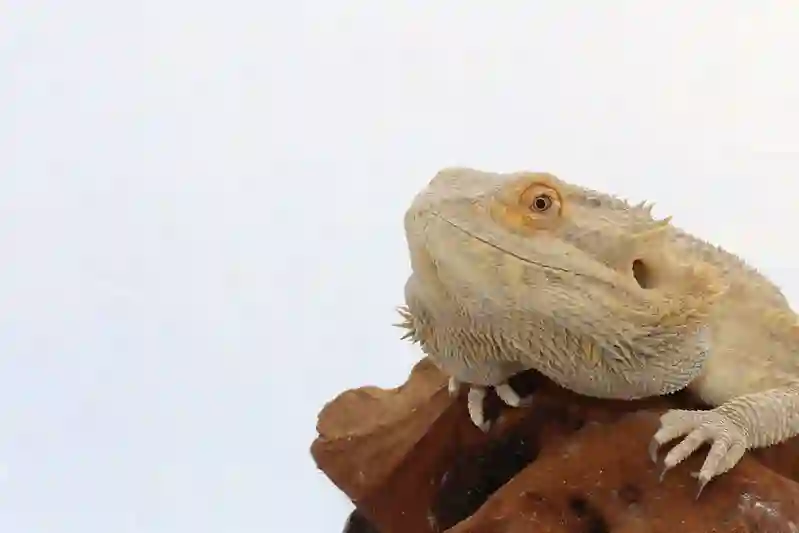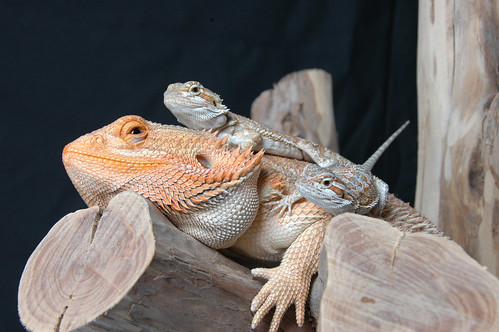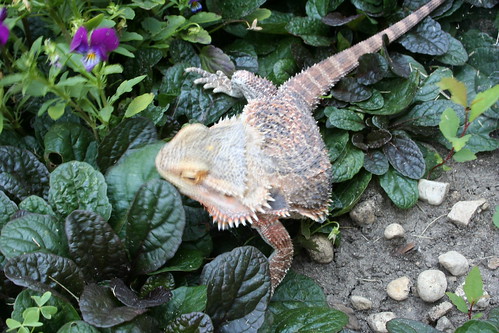The most likely reason your bearded dragon’s tail is turning white is shedding. Bearded dragons shed their skin periodically, and during this process, their skin may appear dull, pale, or white.
Younger dragons can shed as often as every few weeks, while adults usually shed a few times a year. Shedding typically occurs in patches, so it’s normal for only the tail to appear white at first.
However, if the white tail is accompanied by other symptoms such as lethargy, loss of appetite, abnormal behavior, or any other unusual symptoms, it could indicate an underlying health issue. In such cases, it is crucial to seek veterinary care promptly to address any potential problems
The Normal Color of a Bearded Dragon Tail
The normal color of a bearded dragon’s tail is typically yellow or tan. However, the tail can change color due to several reasons, including growth, shedding, or hot and cold temperatures.
During the shedding process, the tail can turn white, and the skin will shed first or last, so you’ll see the color difference in the tail as a contrast to the rest of its color.
If the tail appears blackish in color, it could be a sign of tail rot, which is a condition where the tail darkens and rots due to an unhealthy blood flow. If the tail appears pale or white, it could be a sign that the bearded dragon is shedding
Reasons Why a Bearded Dragon Tail Might Turn White
When a bearded dragon’s tail turns white, it can be due to several reasons. The most common reason is shedding.
Bearded dragons shed their skin periodically, and during this process, their tail may appear white as the old skin flakes off and the new skin underneath becomes visible.
Shedding is a natural process for bearded dragons, and younger dragons may shed more frequently, even every few weeks, while adults shed a few times a year. Other possible reasons for a bearded dragon’s tail turning white include:
- Sleeping: Bearded dragons may turn white while they sleep, which is a normal behavior.
- Temperature and humidity: Extreme temperature or humidity issues can cause a bearded dragon’s tail to turn white. If the white tail is the result of severe temperature or humidity problems, it is important to seek veterinarian assistance as it can lead to health issues.
- Dying: In rare cases, a bearded dragon turning white may be a sign of a serious condition, such as dying. If a bearded dragon is dying, it may exhibit other symptoms like lethargy and loss of appetite.
It’s important to note that these reasons are generalizations, and if you are concerned about your bearded dragon’s health, it is always best to consult a veterinarian for a proper diagnosis and advice.
Shedding:
Bearded dragons, like other reptiles, shed their skin regularly. This process is essential for their growth and health.
Shedding is a natural process that occurs throughout the bearded dragon’s life, and it allows them to get rid of old or damaged skin cells. During shedding, the outer layer of skin peels off in small pieces.
The Process of Shedding:
The shedding process can last from a few days to several weeks and consists of several stages. Before shedding begins, the bearded dragon’s skin will start to appear duller than usual.
This is because a new layer of skin is growing beneath the old one. As new skin cells grow, they push away the older skin cells.
Once this process starts, the outer layer of the beardie’s skin cracks open around its head and neck area, then around its body until it reaches its tail area. If all goes well (meaning your pet is healthy), then it should take about 7 – 14 days for a complete shed cycle.
How Shedding Can Affect Tail Color:
During shedding time, some bearded dragons might show changes in their tail coloration as well as other parts of their body.
White patches on your pet’s tail are common during this time and nothing to worry about if all else looks normal (eating drinking – normal behavior). The white coloration you may notice on your beardie’s tail could indicate that the shedding process has already started in that area.
The white patches can also be dead or dying layers of topcoat preparing itself to fall off during a shed cycle. – Just keep an eye on these changes during shedding cycles but remember there is nothing alarming about white patches on your beardies’ tail if everything else looks good!
Injury
When Tail Trauma Happens
Bearded dragons are prone to tail injuries, and this can happen in different ways. For instance, if a bearded dragon’s tail gets caught in something or gets slammed in a door, it can experience trauma that causes discoloration or even loss of the tail altogether. The severity of the injury will determine how much discoloration occurs and whether it is permanent.
Types of Injuries That Can Cause a White Tail
There are different types of injuries that can cause discoloration or loss of the tail in a bearded dragon. Some common ones include:
- Burns – This happens when a bearded dragon’s tail touches a hot surface like an exposed light bulb or heater.
- Fractures – A fractured tail can cause bleeding and swelling which may lead to white coloring on the affected area.
- Bites – Bearded dragons may sometimes bite each other, leading to injuries on their tails.
- Amputation – If an injury is severe enough, it may require amputation of part or all of the tail. Once this happens, new growth will usually occur but with some differences like having white color patches where there weren’t any before.
Treatment for Injured Tail
If you suspect your bearded dragon has experienced an injury on its tail, it’s essential to seek veterinary care right away. Your veterinarian will assess the severity of the injury and recommend appropriate treatment based on this assessment.
In cases where there is minor trauma like scrapes or bruises, pain relief medication and application of antiseptic products would suffice as treatment while extensive injuries might require more advanced interventions such as wound dressing or surgical reconstruction. Understanding how injury can cause your bearded dragon’s tail to turn white is crucial.
The symptoms of such injuries can range from discoloration to loss of the tail, depending on the severity of the injury. Therefore, it’s essential to provide appropriate care for your pet by seeking veterinary assistance as soon as you notice any signs of tail injury.
Illness
Bearded dragons can be susceptible to various illnesses that can also cause changes in the color of their tail. Fungal infections, for example, can cause a white or yellowish appearance on the tail.
These infections usually occur in areas of the body with high levels of moisture and humidity, such as the tail. Parasites such as mites and ticks can also cause discoloration on a bearded dragon’s tail.
Fungal Infections
Fungal infections are often caused by poor hygiene, unsanitary living conditions or from being housed with other reptiles who may have fungal spores on their skin. A fungus-infected bearded dragon may become lethargic and lose its appetite. The fungus may appear as white or yellowish patches which can spread rapidly if not treated promptly.
Parasites
Mites are tiny parasites that feed on blood and live under the scales of a bearded dragon’s skin. They are sometimes visible as small brown or black spots along the tail and other parts of the body, particularly armpits and groin areas.
Ticks are larger than mites and attach themselves to a bearded dragon’s skin, feeding on its blood until they become engorged before falling off.
Explain how these illnesses can affect the overall health of your beaded dragon
Illnesses like fungal infections and parasites not only affect your beaded dragon’s physical appearance but also its overall health and well-being. If left untreated, these illnesses could eventually lead to severe complications such as loss of appetite, weight loss, dehydration, seizures, or even death.
If you suspect that your beaded dragon is showing symptoms of any illness affecting its tail coloration or behavior you should immediately seek veterinary advice to get it diagnosed correctly so that appropriate treatment for its condition can commence immediately.
Conclusion
Changes in the color of your bearded dragon’s tail can be an indication of several underlying issues that could affect its overall health and well-being. The most common reasons for a whitetail are shedding, injury, or illness.
Shedding is normal, but injury and illness need to be treated promptly to prevent further complications that could lead to death. It is best practice to keep a close eye on your pet’s behavior and physical appearance regularly to identify any changes or symptoms of illnesses early enough for prompt treatment so as to ensure a healthy and happy life for your reptilian pet.


